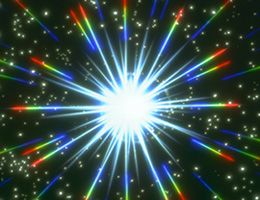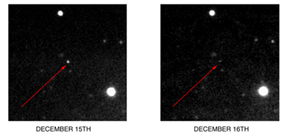This is an image of the area of the sky where the gamma-ray burst was
observed. You'll see that the star at the center of the image has
significantly faded in the course of one day (indicating rapidly dimming
afterglow of the gamma ray burst).
Click on image for full size
NASA Photo Credit: Columbia University
The Biggest Explosion Since the Big Bang
News story originally written on May 11, 1998
A burst of energy was measured on December 14, 1997 by the Italian/Dutch BeppoSAX satellite and NASA's Compton Gamma Ray Observatory satellite. Findings are just being released that claim that this burst is the most powerful explosion since the Big Bang. In fact, Caltech professor George Djorgovski, one of the two principal investigators on the
team from the California Institute of Technology, said that, "For about one or two seconds, this burst was as luminous as all the rest of the
entire universe."
This gamma-ray burst came from a faint galaxy 12 billion light years away. "The energy released by this burst in its first few seconds staggers the imagination," said Caltech professor Shrinivas Kulkarni, the other principal investigator on the team. This burst released several hundred times more energy than a supernova!
Few theoretical models sufficiently explain this release of energy. Kulkarni explained, "There are recent models, involving rotating black holes, which can work. On the other hand, this is such an extreme phenomenon that it is possible we are dealing with something completely unanticipated and even more exotic!"
You might also be interested in:

No one knows their cause or how far away they are, but the NEAR (Near-Earth Asteroid Rendevous) spacecraft took significant steps toward revealing the mysteries behind gamma-ray bursts. It was unexpected
...more
It was another exciting and frustrating year for the space science program. It seemed that every step forward led to one backwards. Either way, NASA led the way to a great century of discovery. Unfortunately,
...more
The Space Shuttle Discovery lifted off from Kennedy Space Center at 2:19 p.m. EST, October 29th. The sky was clear and the weather was great as Discovery took 8 1/2 minutes to reach orbit for the Unitied
...more
A moon was discovered orbiting the asteroid, Eugenia. This is only the second time in history that a satellite has been seen circling an asteroid. A special mirror allowed scientists to find the moon
...more
Will Russia ever put the service module for the International Space Station in space? NASA officials are demanding an answer from the Russian government. The necessary service module is currently waiting
...more
During a period of about two days in early May, 1998, the ACE spacecraft was immersed in plasma associated with a coronal mass ejection (CME). The SWICS instrument on ACE, which determines unambiguously
...more
J.S. Maini of the Canadian Forest Service has referred to forests as the "heart and lungs of the world." Forests reduce soil erosion, maintain water quality, contribute to atmospheric humidity and cloud
...more















